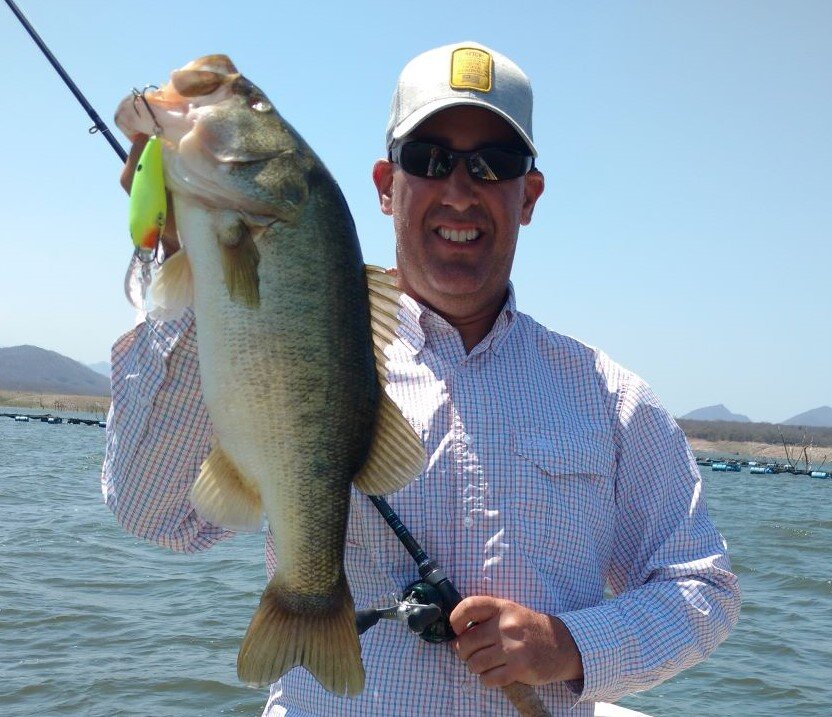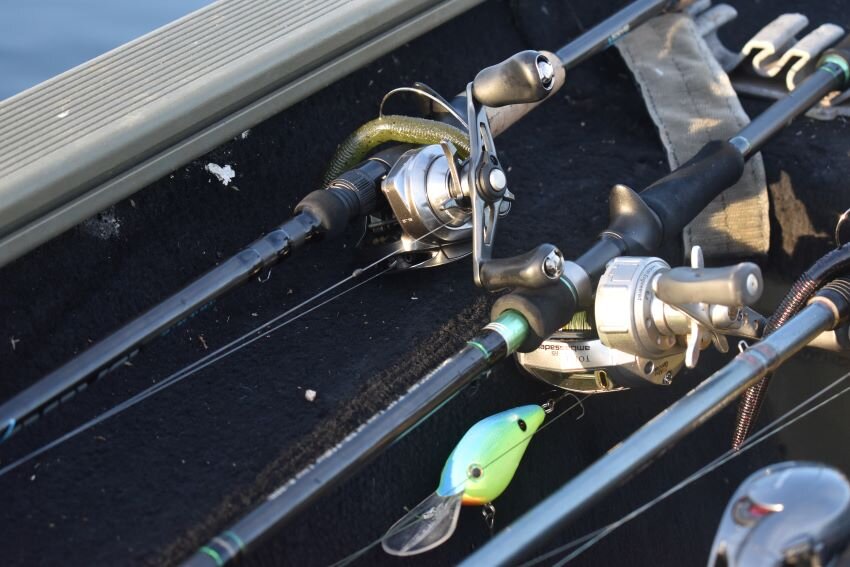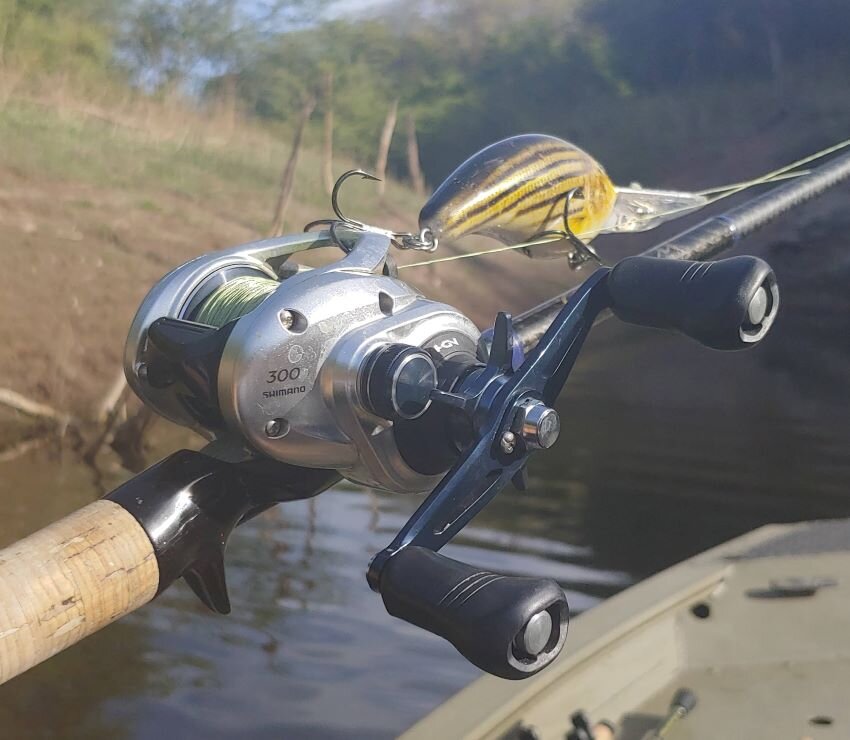Cranking Combos for Mexico
One of the many great things about fishing at Anglers Inn’s properties at Lake El Salto and Lake Picachos is that they provide high-quality St. Croix rods free of charge. There are a variety of actions, and lengths up to 7’10”, so you’re covered for just about any technique you might want to employ. Just bring your own reels, spooled up with the line of your choice, and you’re good to go.
Despite that option, many of you will still want to bring your own rods South of the Border. I get it. You don’t trust someone else’s sticks. Or maybe you’re just super-comfortable with your own. Perhaps you want to represent a sponsor or a friend’s company. No matter what, it’s your choice.
If you do elect to bring rods, I strongly suggest that you bring a dedicated crankbait combo. I’m not talking about something specifically tailored to squarebills or lipless baits, but rather a rod and reel setup aimed at chunking and winding big deep divers. Up until a decade or so ago, you could get away with something more generalized for throwing what were then the deepest-diving plugs – like the Fat Free Shad – but with the addition of behemoths like the Strike King 10XD you’re going to need something that makes the job easier and more efficient. The wrong gear will wear you out.
It starts with a rod that is at least 7’6”, and for most of us closer to eight feet. That allows you to make longer casts. A long handle will give you the leverage that is essential for two-handed casts. My preferred retrieve is to crank the handle until the lure contacts the bottom, and then make long sweeps of the rod (without turning the handle) to keep it there, followed by a short pause. Often the bass will bite on the pause, and that can become a pattern unto itself. You’ll want a rod that allows you to feel what the lure is doing, but at the same time one that flexes deep into the blank.
For several years I’ve used the 7’11” Megabass Orochi XX “Launcher” (retail $299) and it has performed flawlessly through hundreds of Mexican bass. Like many JDM rods, mine has a removable handle which makes it easier to pack in a 7’6” rod tube, but I do not think the current iteration offers that feature.
Hanna cranks with the IRod Genesis Crank Launcher, which is also 7’11” and it likewise has battled lots of big bass up to about 8 pounds into the boat. At a retail price of $149, this is one of the best bargains in fishing, especially if you buy it on Black Friday or during some other sale. After she started using this one, I purchased several more IRods for my own use.
It is also critical that you invest in an oversized, durable reel. I specified “durable” because after a few days of hard cranking with a poorly-constructed model you will feel the tolerances loosen and the performance deteriorate. This is a technique that is hard on your gear. I specified “oversized” because you’re going to need a lot of line. Your guide will work to position the boat so that you are casting with the wind, and when it’s really howling you will likely have no problem running a standard-sized reel down to the knot on your spool.
For the past few years I’ve cranked with a Shimano Tranx 300, a reel that served me well on payara in the Amazon and should excel for light saltwater applications, too. I have the TRX300A, which weighs 11.6 ounces and has a 5.8:1 gear ratio. I plan to invest in the TRX300AHG, which weighs the same but offers a 7.6:1 retrieve speed. On this most recent trip, I also used the beefy Shimano Cuardo CU300HGK (6.6:1) and I was very impressed in its limited usage.
Hanna has a discontinued version of the Abu-Garcia Toro (6.4:1) that is a couple of ounces lighter than the Tranx or the Curado, but still holds a ton of line. Current Abu options that might suffice are the Toro Beast (although at 13+ ounces it’s a little heavy), the Revo Beast X (9.3 oz., 6.4:1), the Revo Winch (5.4:1, lesser spool capacity), or the Revo Beast (9.5 oz.; 5.8:1 or 7.3:1 gear ratios).
One departure from crankbaiting orthodoxy that we’ve completely bought into is the use of braid. I like Power Pro Maxcuatro in 30-, 40- or even 50-pound test. It has a thin diameter that allows the bait to get down quickly and stay down. You will have to adjust your reaction when the bait digs into a tree (less stretch than fluoro = gets hung up more) and you should endeavor to retie frequently when fishing around rock. The lack of stretch in the braid makes a proper limber cranking rod imperative – otherwise you are going to lose some fish, especially when they surge at the boat. If you cannot get away from fluorocarbon, choose a high-grade line and no less than 17-pound test (or 14 for you daredevils).
Play the fish carefully, but not slowly, and work hard to prevent them from jumping. If they get airborne with that big plug flapping around outside their mouths it increases the chances that they’ll use that leverage to free themselves.
One final note, not about tackle so much as about cranking efficiency: Bring extra trebles, split rings and split ring pliers. The Anglers Inn guides are exceptional at freeing snagged lures, but eventually the combination of getting snagged, bouncing off of rocks and (hopefully) using the pliers on a lot of fish will cause even quality trebles to dull. Fresh hooks will keep your trophies buttoned up, which is especially critical in the case of fish that slap at the lure and end up getting hooked on top of the head, in the chin, or in the tail. Even if your purported “10-pounder” turns out to be a tail-hooked 5, it still counts in the memory book.















